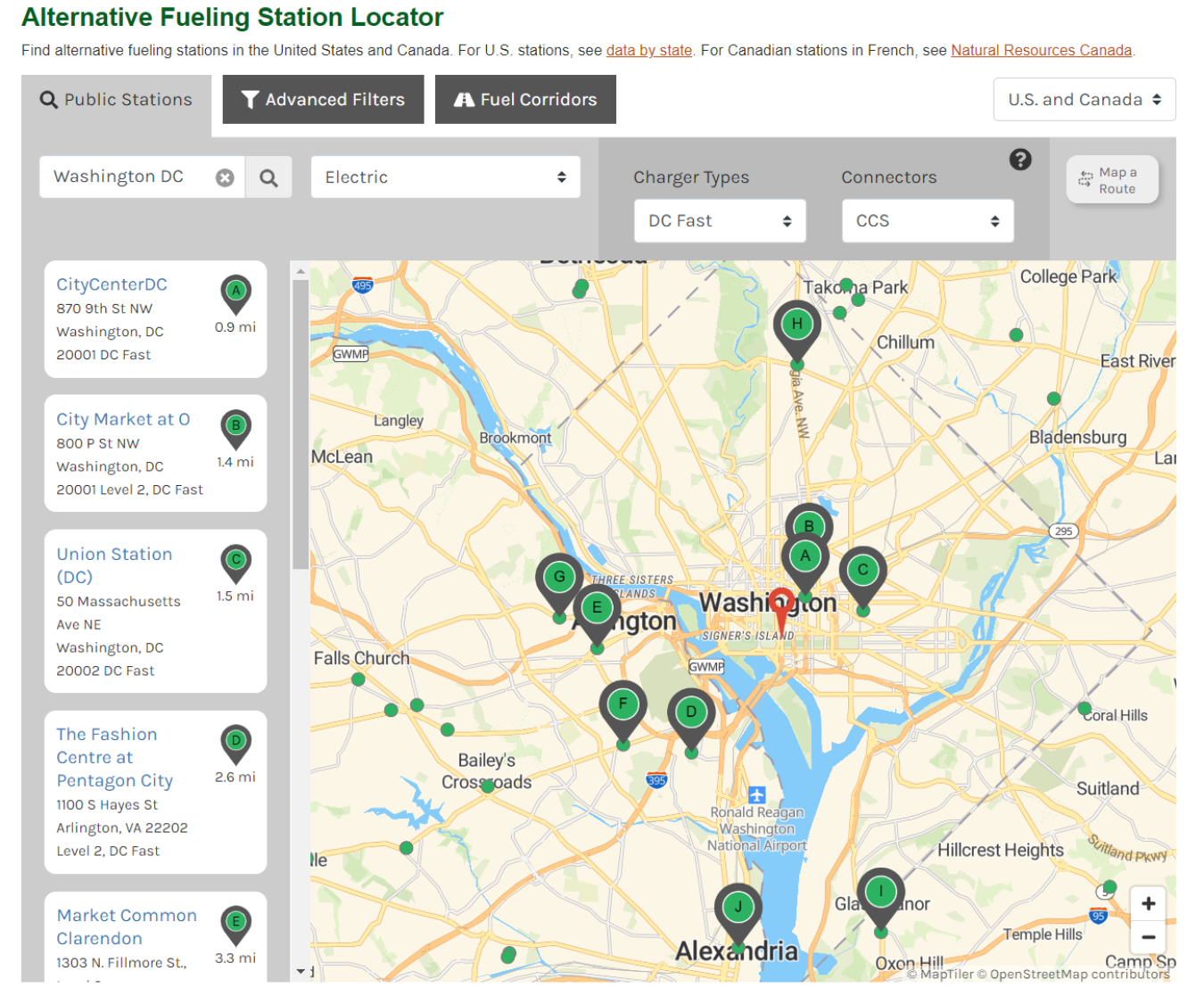Step 11 of the site-level federal fleet ZEV Ready process is to identify electric vehicle supply equipment (EVSE) at non-agency locations.
Navigate the ZEV Ready Process
| Design Phase Steps |
|---|
| 8. Engage with key site stakeholders |
| 9. Coordinate with local utility service |
| 10. Complete site assessment and design EVSE |
| 11. Identify EVSE at non-agency locations |
| 12. Work with leadership to secure EVSE funding |
Return to the ZEV Ready Center to see all 15 steps.
Primary Audiences
 | Site ZEV Champions |
 | Site Location Fleet Managers |
The site ZEV champion and site location fleet managers are the primary audiences for identifying EVSE to charge fleet zero-emission vehicles (ZEVs) when they operate away from the fleet site location. In some instances, ZEVs will require charging at non-fleet locations, such as home-to-work (HTW) uses and other non-agency garage locations, or will require use of public charging stations. The sections below discuss the considerations for fleet manager EVSE planning to support ZEVs at non-agency locations.
Home-to-Work Considerations
Certain federal employees may be authorized by the "head of the Federal agency" to drive a federal fleet vehicle between their residence and place of work or field operations (31 U.S.C.1344 and General Services Administration [GSA] FMR Part 102-5).
In addition to the deployment of EVSE at fleet garaged locations, many agencies must also plan for the use of ZEVs in a HTW environment. As outlined in Federal Management Regulation (FMR) Bulletin B-35, federal agencies are permitted "in certain limited situations to authorize employees to use Government passenger carriers for transportation between their residences and their places of work." This bulletin provides suggested policies for HTW transportation. FEMP developed the Federal Home-to-Work Electric Vehicle Program Guide as a guide for federal agencies in developing their own internal program documents to manage government-owned EVs used for home-to-work travel. Agencies should consult their legal counsel in developing and implementing HTW vehicle policies for EVSE.
In these HTW situations, operators will often keep vehicles at personal residences during the longest dwell periods, such as overnight, since most of the vehicle charging will not occur at a central garage or agency location. Therefore, agencies must determine other solutions to ensure the vehicles have access to charging where they are garaged or operated since the cost of that energy is paid for by the agency.
The following solutions outline a few programs that could address these concerns as well as an initial comparison of some pros and cons of each. However, many other solutions may also exist or could be developed. Agencies should continuously monitor changes in HTW policies, changes in fleet composition, and the effectiveness of HTW programs.
An agency standardized rate EVSE reimbursement approach includes the deployment of Level 2 EVSE, managed and paid for by the agency, into each residence where a HTW vehicle will be parked. This requires each HTW operator to initially pay for the electricity through their monthly electricity bill and get reimbursed for the amount of that bill corresponding to fleet charging. In order for an agency to determine the level of reimbursement necessary, the fleet manager must monitor energy delivered to the vehicle from the residence through either EVSE reporting or vehicle telematics. It will also be important for the fleet manager to determine the difference between the energy used for home and public charging, which will be paid for by using a fleet card, when reimbursing the operator for the cost of electricity.
Pros Cons The agency has full control of EVSE deployment and use.
The collection of energy and cost data will be streamlined for reporting.
Operators will benefit from the installation of EVSE in their residence, simplifying adoption.
Could result in overbuilt charging infrastructure (some EVs may not require Level 2 EVSE).
Installation and maintenance administrative costs will be high.
Some installations may be expensive due to upgrades required for some residences.
An agency standardized mileage rate approach uses the miles driven in a vehicle to estimate charging costs using a standard mileage rate. This would require each HTW operator to cover all the costs of installing EVSE and providing electricity for the vehicle and be reimbursed based on the vehicle miles driven. The standard mileage rate should be developed based on GSA's per-diem rates for travel. This accounts for the typical lifetime costs of refueling a vehicle, including electricity, charging infrastructure, public charging, and conventional fuel for plug-in hybrid electric vehicles (PHEVs). This market-based solution would incentivize the most efficient use of EVSE but place the responsibility of installing any necessary charging equipment on the operator.
Pros Cons A market-based solution would incentivize the most economical EVSE deployment options.
The only reporting that is necessary would be mileage and a corresponding energy estimate.
Agencies would not be required to manage the installation of EVSE in residences.
A standard mileage rate will inherently not be one-size-fits-all (compared to GSA per-diem).
The burden of installing EVSE in their residence, if necessary, is on the operator.
The operator must cover all vehicle energy needs and may not use a fleet card.
An agency low-power EV approach is designed for vehicles with a low daily demand for electricity such as those that operate few electric vehicle miles travelled (eVMT). These include both PHEVs with their smaller batteries and limited EV energy needs, as well as battery electric vehicles (BEVs) with low daily eVMT and longer charge session dwell time requirements where Level 1 charging is sufficient. This program supports HTW vehicles using 120-V outlets commonly available in residential settings with portable Level 1 EVSE for charging vehicles. As a result, this program could leverage existing 120-V receptacles at residences or install a new 120-V receptacle on a dedicated circuit, if necessary.
Each HTW operator would initially pay for the electricity through their monthly electricity bill and be reimbursed for the bill's amount corresponding to the HTW vehicle charging. In order for an agency to determine the level of reimbursement necessary, the fleet manager must monitor energy delivered to the vehicle from the residence through either EVSE reporting or vehicle telematics. When calculating reimbursement, the fleet manager must take into account vehicle public charging or conventional fuel transactions (for PHEVs) since these are typically paid for with a fleet card.
Pros Cons Installing 120-V receptacles simplifies EVSE deployment strategies.
Combination of low-VMT BEVs and PHEVs expands EV opportunities to entire fleet.
Allows for rapid deployment of ZEVs and EVSE (120-V receptacles are simpler/lower cost to install).
Low-electricity EVs result in lower operational savings from electric drivetrain efficiencies.
Requires consistently low and accurate VMT or some vehicles could require the use of public charging and fueling transactions (e.g., PHEVs).
Requires focus on energy type use (monitor % electric miles) for PHEVs.
Non-Agency Locations
Site location fleet managers should consider the benefits of deploying EVSE to support agency ZEVs when they are garaged at non-agency locations, such as co-locating EVSE charging opportunities with state, local, or other federal government or private facilities nearby. Typically, the agency will have little control over physical facilities at non-agency fleet locations and will need to engage with the facility owner to either:
- Have the non-agency location install EVSE to support agency ZEVs
- Provide funding for the deployment of EVSE at the non-agency location
- Use alternative infrastructure, such as publicly available or other agency-owned charging stations.
If interested in using EVSE at non-agency locations, the agency fleet manager responsible for vehicles at non-agency locations (and other key stakeholders as necessary) should contact facility managers at any non-agency location where ZEVs could potentially be deployed. At non-agency locations with existing or planned EVSE, the agency fleet manager should determine if agency ZEVs could use that infrastructure or if agency funds may be used to support expansion of that infrastructure to be used by agency ZEVs, such as installing additional EVSE. At other non-agency locations without EVSE or planned EVSE, the agency fleet manager should work with the facility managers to determine the feasibility and suitability of installing EVSE to support each agency's ZEVs and timing charging opportunities appropriately to best meet all fleet operations.
A key component of this conversation will be the cost of installing EVSE; the party(ies) responsible for funding its deployment, ongoing maintenance, or network fees or management costs; and exploring each agency's fleet management policies, including setting up a mechanism for each agency to pay for its own use of electricity.

Public Charging
Although most fleet EVs will receive much of their energy from EVSE owned by the agency and located at the fleet location, some longer trips will require the use of public EVSE for mid-day charging needs. To determine the availability of public charging, DOE developed an Alternative Fueling Station Locator tool to help identify the location, charger type, and power rating of public EVSE. The tool is also helpful in mapping nearby stations with CCS DC fast charging capabilities, like in Figure 1, as well as display the designated alternative fuel corridors as designated by the Federal Highway Administration. Additionally, the FleetDASH AFV Screening Tool allows federal employees to compare public EVSE locations to the locations where their agency's existing gasoline vehicles fuel.
For additional guidance, refer to GSA's Charge Your Electric Vehicles at Public Stations fact sheet.
Becoming ZEV Ready

As part of the Charging Ready component of the ZEV Ready certification, the site ZEV champion and the site location fleet manager should identify EVSE solutions to provide charging at non-fleet locations as needed, including HTW uses and other non-agency locations, and help support use of public charging stations as needed.
| PHASE | ZEV READY | STEP | ACTIONS |
|---|---|---|---|
| DESIGN |
| 11. Identify EVSE for ZEVs at non-agency locations | ✔ The site location fleet manager will lead efforts to provide EVSE solutions for ZEVs used in a home-to-work environment, including working with the agency legal counsel on appropriate policies and evaluating different programs to reimburse cost for EVSE infrastructure and electricity use. ✔ The site location fleet manager will coordinate with facility managers at any non-agency location where ZEVs could potentially be deployed to determine opportunities to deploy or share EVSE at the facility location. ✔ The site location fleet manager will assist ZEV operators in identifying public EVSE to support vehicle charging either nearby to the facility or along the vehicle route away from the facility. |


